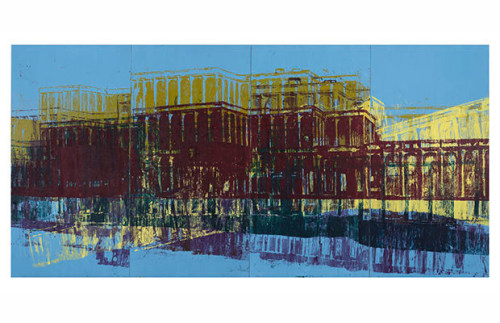
Modern Magazine: BECK HOUSE, 2016. | PHOTOGRAPH BY JOHN BERENS; COURTESY OF ENOC PEREZ AND PETER BLUM GALLERY, NEW YORK.
Enoc Perez takes Philip Johnson to the canvas in Dallas
By SAMMY DALATI | February 27, 2018
Some artists paint portraits. New York–based artist Enoc Perez has made modernist architecture his subject. Painting in a slashing overlay style that seems to channel both Andy Warhol and Franz Kline, in Liberty & Restraint, an exhibition that opened last month at the Dallas Contemporary and eight locations throughout the city, he investigates the gallery of local buildings designed by architect Philip Johnson. MODERN’s associate editor Sammy Dalati caught up with Perez at his cavernous studio in Astoria Queens, and asked him about his process and his inspiration for the show.
Sammy Dalati/MODERN MAGAZINE: What got you interested in making paintings of modernist buildings?
Enoc Perez: I’m just a big fan of architecture. Kind of like how Warhol gravitated to and depicted movie stars, I always liked architecture, ever since I was a kid.
MM: Why Philip Johnson’s work?
EP: There’s an abundance of his buildings in Dallas and it just made sense. I had already done a show at Philip Johnson’s Glass House and I had done a commission for a Philip Johnson building in Denver—the Wells Fargo Center there—so when the museum presented me with the idea, I thought, “You know, I’ve been working on the subject of Philip Johnson and I want to finish the subject.” We started planning for the show during the presidential campaign and I had already been doing my homework on Johnson and thought “Oh, my God, this guy in many ways describes the moment we’re in,” in terms of his ideology, his politics, his ever-changing styles of architecture—he’s almost like a father of post-capitalist architecture. You have to remember that this guy had a fascist past. He’d go to Nazi rallies. The inspiration for the Glass House was a house he saw in Poland that was burned down during the occupation and the only thing that was left was the floor and the chimney. He’s a figure who has a double edge. He did a lot of great things for culture, for American culture, he brought all these guys back from Germany—Albers, Mies van der Rohe, etc. On the other hand, there was this really weird time for him in the thirties.
MM: How do you make these paintings?
Enoc Perez: I select an image and project it onto a piece of paper that’s placed up against a canvas. Oil paint is applied to the back of the paper, and when an assistant traces the projected image on its front, what you get on the canvas is something like a carbon-paper transfer—a primitive type of printmaking. That gives us the underpainting, and using little pieces of paper I push in even more color little by little. So at the end of the day we make a painting without using any brushes. Which isn’t the whole point of the process, but it’s a byproduct.
MM: Dallas Contemporary’s exhibition notes mention that you “believe in painting,” and that this put you at odds with the faculty and students at Hunter College where you studied art in the nineties. Yet you’ve also said that your work is an investigation of the decay of utopian thinking. Would you say you look at the bright side or at the dark side?
EP: I believe in painting as a medium. I know that it can handle even opposite ideas. I can agree with the optimism of architects [who constructed modernist buildings] for a better tomorrow. Whether those visions succeeded or not—that’s a whole different ball game. Myself, I’m positive. I try to be optimistic, cautiously optimistic. Sometimes when I’m putting layer upon layer upon layer the image starts to disintegrate, just like probably the dream itself disintegrates. Do I want to keep dreaming? Of course, but you’re not blind to the reality.